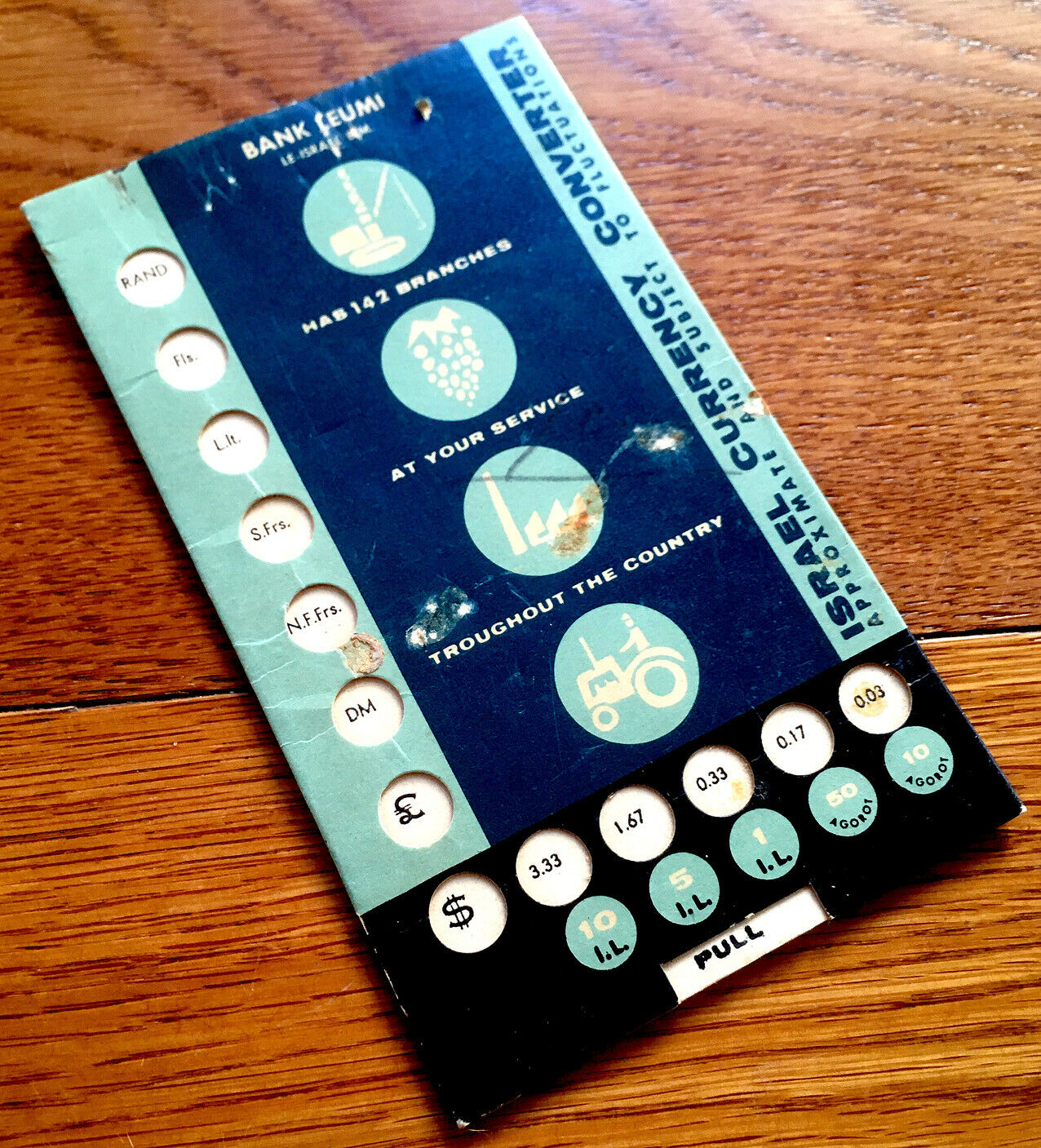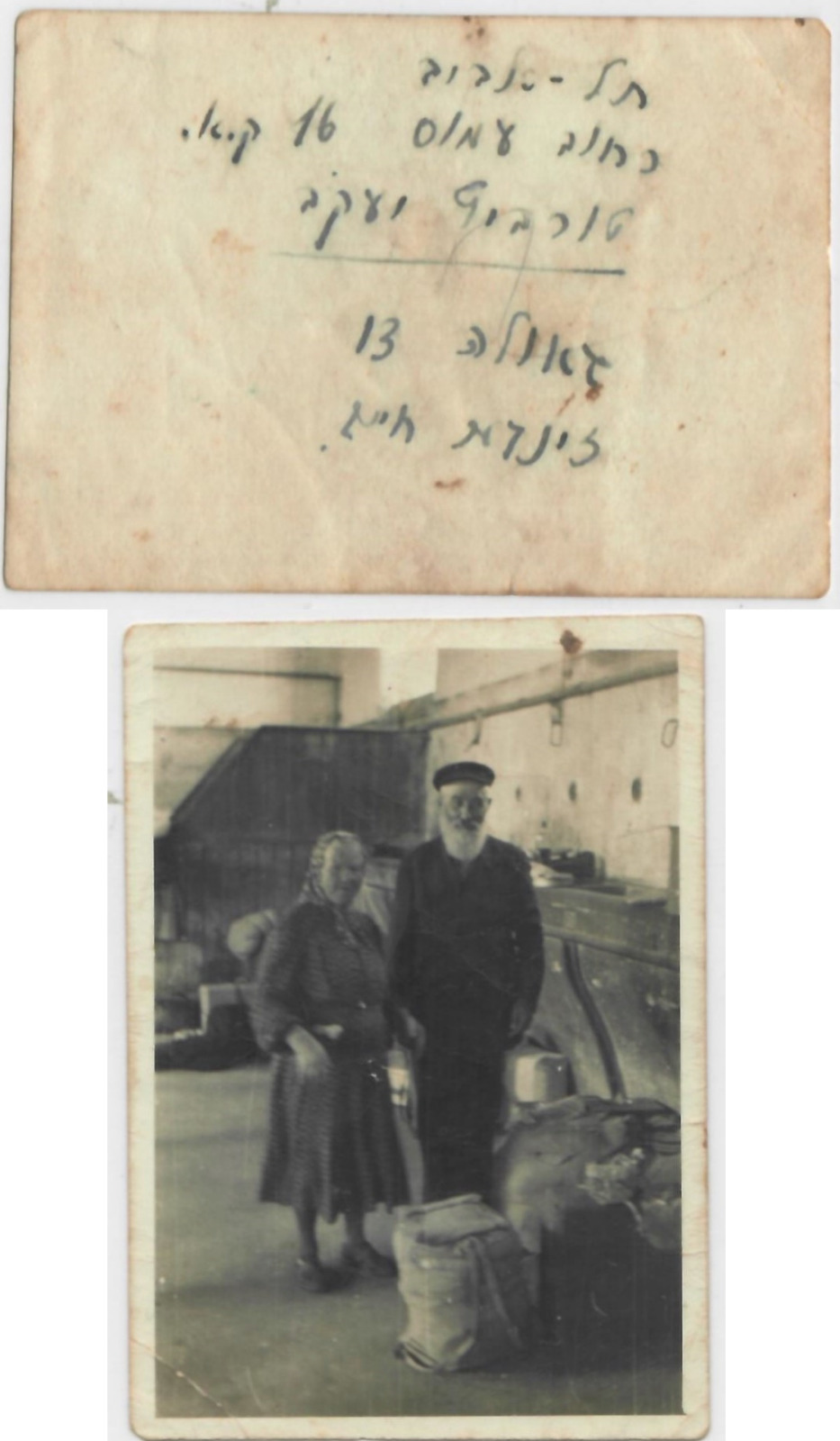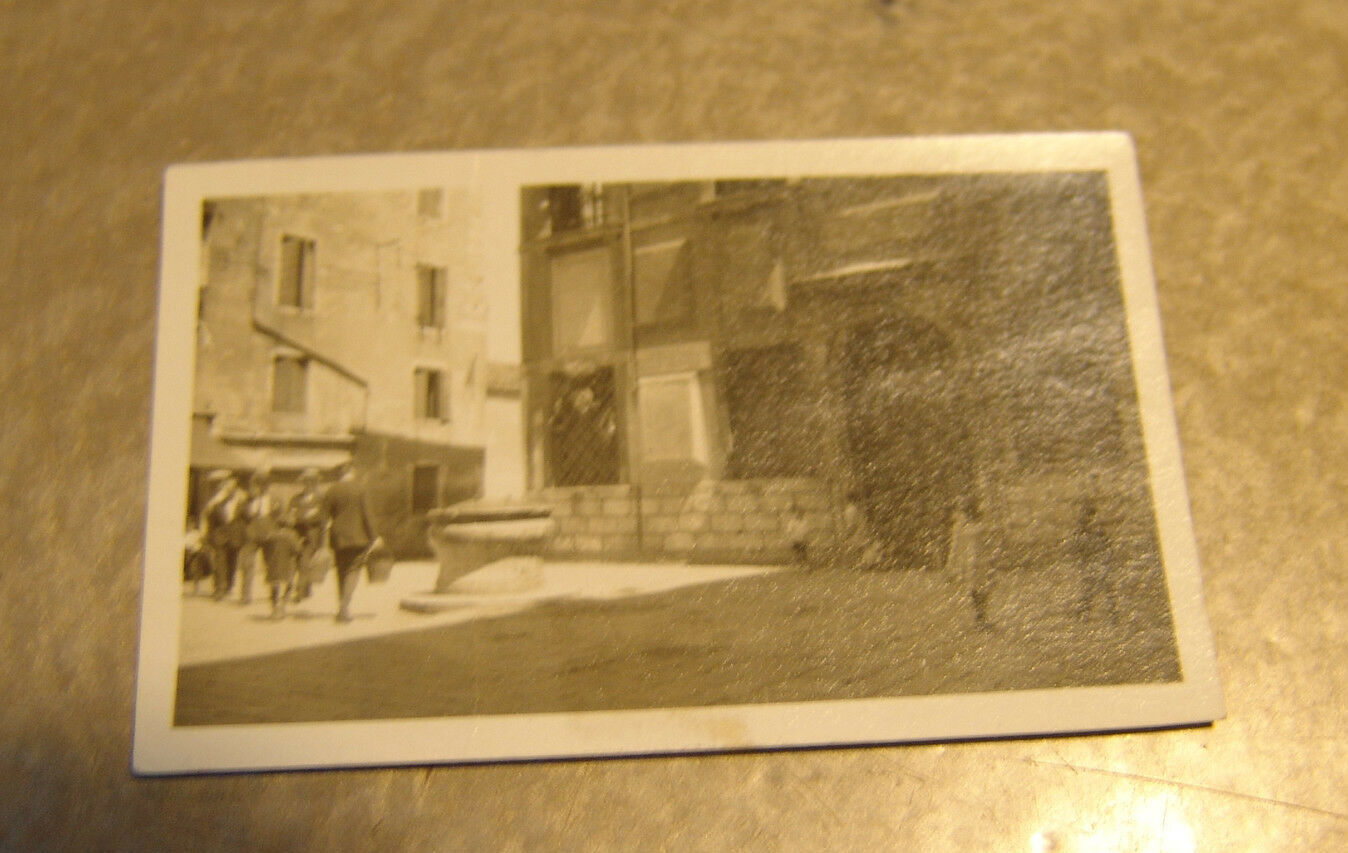-40%
1965 Hebrew ISRAEL CURRENCY CONVERTER Calculator RARE SLIDE RULE Bank CALCULATOR
$ 66
- Description
- Size Guide
Description
DESCRIPTION:
Here for sale is an EXTREMELY RARE original vintage HEBREW CARDBOARD advertising movable SLIDE RULE - CALCULATOR which was MADE IN ISRAEL in 1965 by the National Bank of Israel - BANK LEUMI. It's a MOVABLE CURRENCY CONVERTER - Computing the CONVERTING RATE of the ISRAELI POUND , The Israeli LIRA I.L and Israeli AGOROT against EIGHT CURRENCIES : the AMERICAN DOLLAR USD , The GREAT BRITAIN POUND GBP - STERLING, The SOUTH AFRICAN RAND , The German DEUTSCHE MARK , The FRENCH FRANC , The SWISS FRANC , The ITALIAN LIRA and MORE. The BACK SIDE of the RARE SLIDE RULE provides the exact dates of ISRAELI JEWISH HOLIDAYS in the years 1965, 1966 and 1967. A THRILLIMG RARITY.
The Hebrew SLIDE RULE is being a professional tool for BANKERS and CURRENCY related people , Computing and detailing the requiered CURRENCY data
.
Written in HEBREW and ENGLISH . Each of its two faces provides different kinds of DATA . Measures around 5 x 3 ". Twice as long once pulled out. The vintage SLIDE RULE is USED . It is in very good condition. Working nicely.
( Pls look at scan for accurate AS IS images ) .Will be sent inside a protective rigid packaging
.
AUTHENTICITY
:
The ISRAEL HEBREW SLIDE RULE is fully guaranteed ORIGINAL from 1965 , It is NOT a reproduction or a recently made product or an immitation , It holds a life long GUARANTEE for its AUTHENTICITY and ORIGINALITY.
PAYMENTS
: Payment method accepted : Paypal .
SHIPPMENT
: SHIPP worldwide via registered airmail is $ 25 . Will be sent inside a protective packaging
.
Handling aroud 5 days after payment.
The Israeli pound (Hebrew: לירה ישראלית Lira Yisr'elit, Arabic: جنيه إسرائيلي Junayh Isra'eeli) or Israeli lira was the currency of the State of Israel from 9 June 1952 until 23 February 1980. Its symbol was "I£". The Israeli pound replaced the Palestine pound and was also pegged to the pound sterling at par. It was replaced by the shekel on 24 February 1980, at the rate of 1 shekel = 10 Israeli pounds, which was in turn replaced by the new shekel in 1985. Before the new currency was brought in, the Anglo-Palestine Bank issued banknotes denominated in Palestine pounds. They were in Hebrew לירה א"י (lira E.Y. i.e. lira Eretz-Yisraelit) and Arabic junayh filisţīnī (جنيه فلسطيني).[1] On 1 May 1951, all the assets and liabilities of the Anglo Palestine Bank were transferred to a new company called Bank Leumi Le-Yisrael (Israel National Bank) and the currency name became: lira yisraelit (לירה ישראלית) in Hebrew, junayh isrāīlī in Arabic, and Israel pound in English.[2] The new currency was issued in 1952, and entered circulation on June 9. From 1955, after the Bank of Israel was established and took over the duty of issuing banknotes, only the Hebrew name was used.[3] **** The United States dollar (symbol: $; code: USD; also abbreviated US$ or U.S. Dollar, to distinguish it from other dollar-denominated currencies; referred to as the dollar, U.S. dollar, American dollar, or colloquially buck) is the official currency of the United States and its territories. The Coinage Act of 1792 introduced the U.S. dollar at par with the Spanish silver dollar, divided it into 100 cents, and authorized the minting of coins denominated in dollars and cents. U.S. banknotes are issued in the form of Federal Reserve Notes, popularly called greenbacks due to their historically predominantly green color. The monetary policy of the United States is conducted by the Federal Reserve System, which acts as the nation's central bank. The U.S. dollar was originally defined under a bimetallic standard of 371.25 grains (24.057 g) fine silver or, from 1837, 23.22 grains (1.505 g) fine gold, or .67 per troy ounce. The Gold Standard Act of 1900 linked the dollar solely to gold. From 1934 its equivalence to gold was revised to per troy ounce. Since 1971 all links to gold have been repealed. [6] The U.S. dollar became an important international reserve currency after the First World War, and displaced the pound sterling as the world's primary reserve currency by the Bretton Woods Agreement towards the end of the Second World War. The dollar is the most widely used currency in international transactions. [7] It is also the official currency in several countries and the de facto currency in many others, [8][9] with Federal Reserve Notes (and, in a few cases, U.S. coins) used in circulation. As of February 10, 2021, currency in circulation amounted to US.10 trillion, .05 trillion of which is in Federal Reserve Notes (the remaining billion is in the form of coins and older-style United States Notes).[10] **** The Deutsche Mark (German: [ˈdɔʏtʃə ˈmaʁk] (listen), "German mark"), abbreviated "DM" or "D-Mark" ([ˈdeːˌmaʁk] (listen)), was the official currency of West Germany from 1948 until 1990 and later the unified Germany from 1990 until the adoption of the euro in 2002. In English, it is commonly called the "Deutschmark" (/ˈdɔɪtʃmɑːrk/); this expression is unknown in Germany.[citation needed] The Germans usually called it D-Mark when referring to the currency, and Mark when talking about individual sums.[citation needed] One Deutsche Mark was divided into 100 pfennigs. It was first issued under Allied occupation in 1948 to replace the Reichsmark and served as the Federal Republic of Germany's official currency from its founding the following year. On 31 December 1998, the Council of the European Union fixed the irrevocable exchange rate, effective 1 January 1999, for German mark to euros as DM 1.95583 = €1.[3] In 1999, the Deutsche Mark was replaced by the euro; its coins and banknotes remained in circulation, defined in terms of euros, until the introduction of euro notes and coins on 1 January 2002. The Deutsche Mark ceased to be legal tender immediately upon the introduction of the euro—in contrast to the other eurozone nations, where the euro and legacy currency circulated side by side for up to two months. Mark coins and banknotes continued to be accepted as valid forms of payment in Germany until 28 February 2002. The Deutsche Bundesbank has guaranteed that all German marks in cash form may be changed into euros indefinitely, and one may do so in person at any branch of the Bundesbank in Germany. Banknotes and coins can even be sent to the Bundesbank by mail.[4] In 2012, it was estimated that as many as 13.2 billion marks were in circulation, with one poll from 2011 showing a narrow majority of Germans favouring the currency's restoration (although only a minority believed this would bring any economic benefit).[5][6] **** Italian lira From Wikipedia, the free encyclopedia Jump to navigation Jump to search Italian lira Lira italiana (Italian) Lira banknotes ranging from L.2,000 to L.500,000 L.1,000 coin (1997) ISO 4217 Code ITL Number 380 Exponent 0 Denominations Subunit 1⁄100 Centesimo (withdrawn after World War II) Plural lire Centesimo centesimi Symbol L. (most commonly) or £[1] (rarely) Banknotes Freq. used L.1,000, L.2,000, L.5,000, L.10,000, L.50,000, L.100,000 Rarely used L.500,000 Coins Freq. used L.50, L.100, L.200, L.500 Rarely used L.1, L.2, L.5, L.10, L.20, L.1,000 Demographics User(s) show Italian Republic Kingdom of Albania (1939–43) San Marino (local issue: Sammarinese lira) Vatican City (local issue: Vatican lira) Issuance Central bank Banca d'Italia Website www.bancaditalia.it Printer Istituto Poligrafico e Zecca dello Stato Website www.ipzs.it Mint Istituto Poligrafico e Zecca dello Stato Website www.ipzs.it Valuation Inflation 2.3% (2001) ERM Since 13 March 1979, 25 November 1996 Withdrawn 17 September 1992 Fixed rate since 31 December 1998 Replaced by €, non cash 1 January 1999 Replaced by €, cash 1 March 2002 € = L.1,936.27 This infobox shows the latest status before this currency was rendered obsolete. The lira (Italian: [ˈliːra]; plural lire [ˈliːre]) was the currency of Italy between 1861 and 2002, of the Napoleonic Kingdom of Italy between 1807 and 1814, and of the Albanian Kingdom between 1941 and 1943. Between 1999 and 2002, the Italian lira was officially a national subunit of the euro. However, cash payments could be made in lira only, as euro coins or notes were not yet available. The term originates from the value of a pound weight (Latin: libra) of high purity silver and is thus directly related to the British pound sterling (referred to in Italian as "lira sterlina" or simply "sterlina") from the Germanic silabar; in some countries, such as Cyprus and Malta, the words lira and pound were used as equivalents, before the euro was adopted in 2008 in the two countries. "L", sometimes in a script form ("£"), was the symbol most often used. Until after the Second World War, it was subdivided into 100 centesimi (singular: centesimo), which translates to "hundredths" or "cents". The lira was established at 4.5 grams of silver or 290.322 milligrams of gold. This was a direct continuation of the Sardinian lira and the French franc. Other currencies replaced by the Italian lira included the Lombardy-Venetia pound, the Two Sicilies piastra, the Tuscan fiorino, the Papal States scudo and the Parman lira. In 1865, Italy formed part of the Latin Monetary Union in which the lira was set as equal to, among others, the French, Belgian and Swiss francs: in fact, in various Gallo-Italic languages in north-western Italy, the lira was known as the "franc".[2] This practice has obviously ended with the introduction of the euro in 2002. World War I broke the Latin Monetary Union and resulted in prices rising severalfold in Italy. Inflation was curbed somewhat by Mussolini, who, on August 18, 1926, announced a new exchange rate between lira and Sterling of £1Stg = L.90—the so-called Quota 90, although the free exchange rate had been closer to L.140–L.150 per pound, causing a temporary deflation and widespread problems in the real economy. In 1927, the lira was pegged to the U.S. dollar at a rate of US = L.19. This rate lasted until 1934, with a separate "tourist" rate of US = L.24.89 being established in 1936. In 1939, the "official" rate was L.19.8. After the Allied invasion of Italy, an exchange rate was set at US = L.120 (£1Stg = L.480) in June 1943, reduced to L.100 the following month. In German-occupied areas, the exchange rate was set at RM1 = L.10. After the war, the value of the lira fluctuated, before Italy set a peg of US = L.575 within the Bretton Woods System in November 1947. Following the devaluation of the pound, Italy devalued to US = L.625 on 21 September 1949. This rate was maintained until the end of the Bretton Woods System in the early 1970s. Several episodes of high inflation followed until the lira was replaced by the euro. The lira was the official unit of currency in Italy until 1 January 1999, when it was replaced by the euro (euro coins and notes were not introduced until 2002). Old lira denominated currency ceased to be legal tender on 28 February 2002. The conversion rate is 1,936.27 lire to the euro.[3] All lira banknotes in use immediately before the introduction of the euro, and all post-World War II coins, were exchanged by the Bank of Italy up to 6 December 2011. Originally, Italy's central bank pledged to redeem Italian coins and banknotes until 29 February 2012, but this was brought forward to 6 December 2011. **** The franc (/fræŋk/; French: [fʁɑ̃]; sign: F or Fr),[n 2] also commonly distinguished as the French franc (FF), was a currency of France. Between 1360 and 1641, it was the name of coins worth 1 livre tournois and it remained in common parlance as a term for this amount of money. It was reintroduced (in decimal form) in 1795. After two centuries of inflation, it was redenominated in 1960, with each new franc (NF) being worth 100 old francs. The NF designation was continued for a few years before the currency returned to being simply the franc; some mostly older French residents continued to reference and value items in terms of the old franc (equivalent to the new centime) until the introduction of the euro (for coins and banknotes) in 2002. The French franc was a commonly held international reserve currency of reference in the 19th and 20th centuries. **** The Swiss franc (German: Franken, French: franc, Italian: franco and Romansh: franc; sign: Fr. (in German language), fr. (in French, Italian, Romansh languages), or CHF in any other language, or internationally;[1] code: CHF) is the currency and legal tender of Switzerland and Liechtenstein. It is also legal tender in the Italian exclave of Campione d'Italia.[6] The Swiss National Bank (SNB) issues banknotes and the federal mint Swissmint issues coins. The smaller denomination, a hundredth of a franc, is a Rappen (Rp.) in German, centime (c.) in French, centesimo (ct.) in Italian, and rap (rp.) in Romansh. The ISO 4217 code of the currency is CHF, which is used by banks and financial institutions. The official symbols Fr. (German symbol) and fr. (Latin languages) are widely used by businesses and advertisers, also for the English language. According to Art. 1 SR/RS 941.101 of the federal law collection the internationally official abbreviation – besides the national languages – however is CHF,[1] also in English; respective guides also request to use the ISO 4217 code.[5][2][3][4] The use of SFr. for Swiss Franc and fr.sv. are outdated.[2][3][4] The Latinate "CH" stands for Confoederatio Helvetica. Given the different languages used in Switzerland, Latin is used for language-neutral inscriptions on its coins. **** The rand (sign: R; code: ZAR[a]) is the official currency of South Africa. It is subdivided into 100 cents (sign: "c"). The South African rand is also legal tender in the Common Monetary Area member states of Namibia, Lesotho and Eswatini. Although these three countries each have their own national currency (the dollar, the loti and the lilangeni respectively), all three have been pegged with the rand at par since their introductions, and the rand is still widely accepted as a substitute for them. The rand was also legal tender in Botswana until 1976, when the pula replaced the rand at par. *** The pound sterling (symbol: £; ISO code: GBP), known in some contexts simply as the pound or sterling,[2] is the official currency of the United Kingdom, Jersey, Guernsey, the Isle of Man, Gibraltar, South Georgia and the South Sandwich Islands, the British Antarctic Territory,[3][4] and Tristan da Cunha.[5] It is subdivided into 100 pence (singular: penny, abbreviated: p). The "pound sterling" is the oldest currency in continuous use. Some nations that do not use sterling also have currencies called the pound. Sterling is the fourth most-traded currency in the foreign exchange market, after the United States dollar, the euro, and the Japanese yen.[6] Together with those three currencies and the Chinese yuan, it forms the basket of currencies which calculate the value of IMF special drawing rights. As of mid-2021, sterling is also the fifth most-held reserve currency in global reserves.[7] The British Crown dependencies of Guernsey, Jersey and the Isle of Man produce their own local issues of sterling (the Guernsey pound, the Jersey pound and the Manx pound) which are considered fully equivalent to UK sterling in their respective regions.[8] The pound sterling is also used in the British Overseas Territories: Gibraltar (alongside the Gibraltar pound), the Falkland Islands (alongside the Falkland Islands pound), and in Saint Helena, Ascension and Tristan da Cunha (alongside the Saint Helena pound), others having transitioned to dollar currencies, such as Bermuda in 1970. The Bank of England is the central bank for the pound sterling, issuing its own banknotes, and regulating issuance of banknotes by private banks in Scotland and Northern Ireland. Sterling banknotes issued by other jurisdictions are not regulated by the Bank of England; their governments guarantee convertibility at par. The pound sterling was also used to varying degrees by colonies in the British Empire. ebay5558

















